Strength training routines should naturally involve your core muscles when done with concentration and purpose. Whether you’re engaging in weightlifting, kettlebell swings, or bodyweight exercises, a strong and engaged core is essential for stability and strength. It’s crucial to execute each movement with the right posture and focus on how your core supports your body throughout the exercise. When performed correctly, each repetition offers an opportunity to work towards achieving well-defined abdominal muscles.
The strength exercises included in this guide are crafted to challenge your core through a variety of dynamic movements, different loading methods, and rotational components. By including workouts that emphasize both strength and stability, like front squats and rotational rows, you activate the deep core muscles necessary for a toned midsection. Exercises such as kettlebell swings and side planks push your core to enhance its ability to stabilize and manage external forces, helping to enhance muscle endurance and definition.
Through my coaching experience with athletes and clients, as well as my personal training journey, I’ve learned that focusing on core strength exercises can significantly impact overall performance. These strength training routines not only assist in sculpting defined abs but also enhance your strength in various lifts, improve your capacity to stabilize during high-intensity activities, and support better posture in your everyday tasks. Each workout detailed in this manual has been carefully curated based on research findings and practical application to ensure that you are on the right path to success.
Workout #1
What you need: This workout combines barbell, kettlebell, and dumbbell exercises with core-focused movements on a bench. You will need access to a barbell, kettlebell, dumbbells, and a bench. The entire workout can be completed in about 45 to 60 minutes, including warm-up sets and rest periods between exercises.
This routine is designed to challenge your strength, stability, and core, making it an excellent full-body workout. Make sure to have enough space and the appropriate weights for each exercise.
The Routine:
- Barbell Front Squats (4 Sets + 8 Reps)
- Kettlebell Rotational Row (3 Sets + 15 Reps)
- Dumbbell Side Bends (3 Sets + 12 Reps)
- On-Bench Leg Lowering (3 Sets + 10 Reps)
Directions: Perform the four exercises for the listed number of reps. Ensure that you complete 2 to 3 warm-up sets at lighter weights before tackling the working sets.
Rest as long as you need to catch your breath, recover, and hydrate.
1. Barbell Front Squats
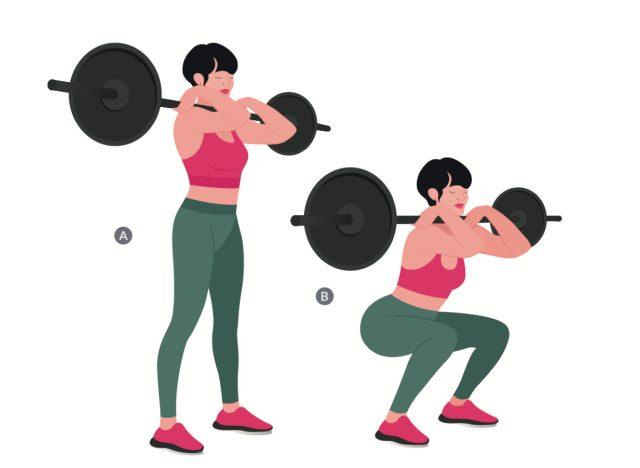
How to do it:
- Stand with feet shoulder-width apart, toes slightly turned out, and a barbell resting on the front of your shoulders.
- Grip the bar with your hands just outside your shoulders, keeping your elbows high.
- Engage your core, then squat down by bending your knees and hips, keeping your chest up and your back straight.
- Lower yourself until your thighs are parallel to the ground or slightly below.
- Push through your heels to return to a standing position, keeping your chest up and elbows high throughout the movement.
- Repeat for the specified number of reps.
2. Kettlebell Rotational Row
How to do it:
- Stand with your feet hip-width apart, holding a kettlebell in your right hand.
- Hinge at your hips, keeping your back straight and your core engaged.
- Rotate your torso slightly to the left as you pull the kettlebell up toward your ribcage, squeezing your shoulder blade at the top.
- Lower the kettlebell back down, controlling the movement, and rotate your torso back to the starting position.
- Repeat for the specified number of reps, then switch sides.
3. Dumbbell Side Bends
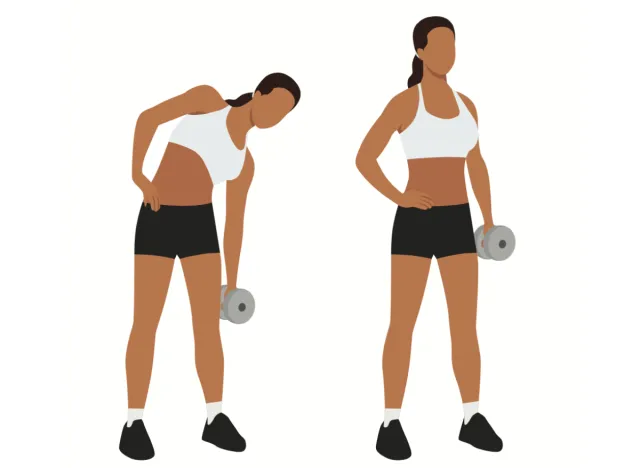
How to do it:
- Stand with your feet shoulder-width apart, holding a dumbbell in your right hand by your side.
- Keep your back straight and your core engaged as you slowly bend to the right, lowering the dumbbell toward your knee.
- Return to the starting position by contracting your oblique muscles on the opposite side.
- Repeat for the specified number of reps, then switch sides.
4. On-Bench Leg Lowering
How to do it:
- Lie on a bench with your head, neck, and shoulders supported and your legs extended straight up toward the ceiling.
- Hold onto the sides of the bench for support, and engage your core by drawing your belly button toward your spine.
- Slowly lower your legs toward the ground, keeping them straight and controlling the movement with your core.
- Stop just before your lower back arches off the bench, then raise your legs back up to the starting position.
- Repeat for the specified number of reps.
Workout #2
What you need: This workout requires a barbell, dumbbells, and some space for functional movements. The routine will help build total-body strength and core stability with a mix of compound lifts and core exercises. It should take approximately 45 to 60 minutes, including warm-up sets and rest periods. Prepare to challenge your lower body, shoulders, and core.
The Routine:
- Barbell Deadlift (4 Sets + 6 Reps)
- Dumbbell Z Press (3 Sets + 12 Reps)
- Suitcase Carry (3 Sets + 40 Yards)
- Alternating Side Planks (3 Sets + 10 Reps per side)
Directions: Perform the 4 exercises for the listed number of reps. Ensure that you complete 2 to 3 warm-up sets at lighter weights before tackling the working sets. Rest as long as you need to catch your breath, recover, and hydrate between sets.
1. Barbell Deadlift
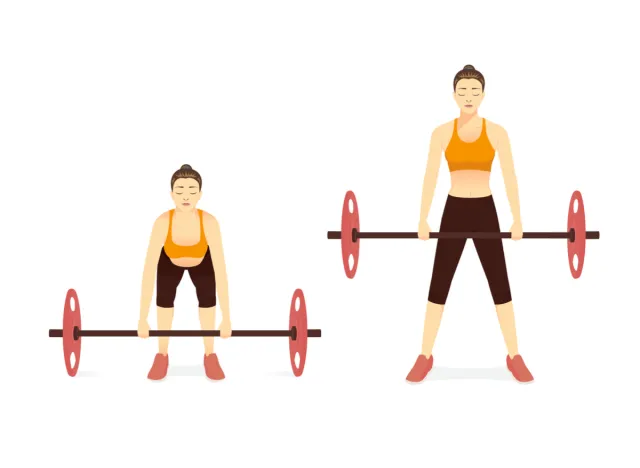
How to do it:
- Stand with your feet hip-width apart with a barbell on the floor in front of you.
- Bend your knees and hinge at your hips, gripping the bar with both hands just outside your legs.
- Keep your back straight, chest up, and core engaged as you lift the bar by driving through your heels, extending your hips and knees.
- Stand tall with the barbell at hip level, then slowly lower it back to the floor by hinging at the hips and bending your knees.
- Repeat for the specified number of reps.
2. Dumbbell Z Press
How to do it:
- Sit on the floor with legs extended straight in front of you, holding a dumbbell in each hand at shoulder height.
- Engage your core and press the dumbbells directly overhead until your arms are fully extended.
- Slowly lower the dumbbells back to shoulder height while maintaining a strong, upright posture.
- Repeat for the specified number of reps.
3. Suitcase Carry
How to do it:
- Stand tall, holding a heavy dumbbell in one hand at your side.
- Engage your core, keeping your shoulders level, and walk 40 yards while maintaining a strong posture.
- Switch hands and repeat on the other side for the specified distance.
- Perform the specified number of sets.
4. Alternating Side Planks
How to do it:
- Start in a side plank position on your left side, with your left elbow directly under your shoulder and your body in a straight line.
- Hold for a moment, then rotate to a side plank on your right side.
- Continue alternating sides for the specified number of reps, keeping your core engaged throughout.
Workout #3
What you need: This workout requires kettlebells, dumbbells, and access to a cable machine. It is designed to build total-body strength, emphasizing core stability, upper-body strength, and lower-body endurance. The routine should take approximately 45 to 60 minutes, including warm-up sets and rest periods.
The Routine:
- Kettlebell Front Rack Reverse Lunge (4 Sets + 8 Reps per side)
- Alternating Dumbbell Bent-Over Row (3 Sets + 12 Reps per side)
- Cable Pallof Press (3 Sets + 15 Reps per side)
- Cable Crunches (3 Sets + 20 Reps)
Directions: Perform the 4 exercises for the listed number of reps. Ensure that you complete 2 to 3 warm-up sets at lighter weights before tackling the working sets. Rest as long as you need to catch your breath, recover, and hydrate between sets.
1. Kettlebell Front Rack Reverse Lunge
How to do it:
- Hold two kettlebells in the front rack position on each side, with the kettlebell resting on your forearm and elbow close to your body.
- Step backward with the opposite leg, lowering your hips until both knees are bent at 90 degrees.
- Push through your front heel to return to the starting position.
- Complete the reps on one side, then switch to the other side.
2. Alternating Dumbbell Bent-over Row
How to do it:
- Stand with your feet hip-width apart, holding a dumbbell in each hand.
- Hinge at your hips and slightly bend your knees, keeping your back straight and core engaged.
- Row the right dumbbell toward your ribcage, squeezing your shoulder blade at the top.
- Lower the dumbbell back down, then repeat on the left side.
- Continue alternating arms for the specified number of reps.
3. Cable Pallof Press
How to do it:
- Set the cable machine at chest height and attach a single handle.
- Stand perpendicular to the machine, holding the handle with both hands, and step away to create tension.
- With your core engaged, press the handle straight out in front of you, resisting the cable’s pull.
- Hold for a moment, then return to the starting position.
- Complete the reps on one side, then switch to the other side.
4. Cable Crunches
How to do it:
- Attach a rope handle to a high pulley on the cable machine.
- Kneel facing the machine, holding the rope with both hands at either side of your head.
- Engage your core and crunch down, bringing your elbows toward your knees while keeping your hips stationary.
- Slowly return to the starting position and repeat for the specified number of reps.
Workout #4
What you need: For this workout, you will need dumbbells, a barbell, a bench, a cable machine, and a mat. The routine targets your upper body, lower body, and core, blending strength training with functional movements. Set aside 45 to 60 minutes to complete the workout, including warm-up sets and rest periods.
The Routine:
- Incline Dumbbell Chest Press (4 Sets + 8 Reps)
- Heel-elevated Barbell Back Squat (3 Sets + 12 Reps)
- Low-to-High Cable Chop (3 Sets + 15 Reps per side)
- Weighted Straight-leg Sit-ups (3 Sets + 10 Reps)
Directions: Perform the 4 exercises for the listed number of reps. Warm up with 2 to 3 lighter sets before moving on to your working sets. Focus on proper form and control for each movement. Take your time resting between sets to recover and hydrate as needed.
1. Incline Dumbbell Chest Press
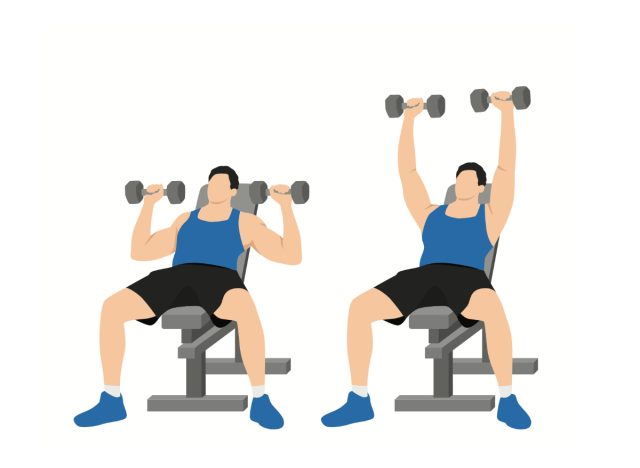
How to do it:
- Set an incline bench at about 30 to 45 degrees.
- Sit on the bench with a dumbbell in each hand, resting on your thighs.
- Lie back and press the dumbbells over your chest, with your palms facing forward.
- Lower the dumbbells slowly until your elbows are at a 90-degree angle.
- Press the dumbbells back up to the starting position.
- Repeat for the specified number of reps.
2. Heel-elevated Barbell Back Squat
How to do it:
- Place a small weight plate under each heel, or use squat wedges to elevate your heels slightly.
- Set up a barbell on a squat rack, position it across your upper back, and grip the bar with your hands slightly wider than shoulder-width apart.
- Step out of the rack and position your feet shoulder-width apart with your heels elevated.
- Engage your core and squat down by bending your knees and hips, keeping your chest up and back straight.
- Lower yourself until your thighs are parallel to the ground, then drive through your heels to return to standing.
- Repeat for the specified number of reps.
3. Low-to-High Cable Chop
How to do it:
- Set a cable machine to the lowest pulley setting and attach a single handle.
- Stand with your feet shoulder-width apart, facing away from the machine, and grab the handle with both hands.
- Pull the handle diagonally across your body, twisting your torso and extending your arms.
- Return to the starting position with control.
- Complete the reps on one side, then switch to the other side.
4. Weighted Straight-leg Sit-ups
How to do it:
- Lie on your back on a mat, legs extended straight, and hold a weight plate or dumbbell across your chest.
- Engage your core and perform a sit-up by lifting your upper body off the ground, keeping your legs straight and anchored.
- Slowly lower yourself back to the starting position with control.
- Repeat for the specified number of reps.
Workout #5
What you need: For this workout, you will need a kettlebell, a medicine ball, and a sturdy surface like a step or low platform for the deficit pushups. The workout incorporates dynamic exercises and bodyweight movements to challenge your strength and endurance. Set aside 30 to 45 minutes to complete the workout, including time for warm-ups, rest, and recovery.
The Routine:
- Deficit Pushups (4 Sets + 8-15 Reps)
- Kettlebell Swing (3 Sets + 12 Reps)
- Med Ball Front Slam (3 Sets + 10 Reps)
- Plank with Alternating Hip Drops (3 Sets + 15 Reps per side)
Directions: Perform the 4 exercises for the listed number of reps. Warm up with 2 to 3 lighter sets before moving on to your working sets. Focus on proper form and control for each movement. Take your time resting between sets to recover and hydrate as needed.
1. Deficit Pushups
How to do it:
- Place your hands on two elevated platforms or weights to create a deficit.
- Assume a pushup position with your body in a straight line from your head to your heels.
- Lower your body toward the floor until your chest nearly touches the ground.
- Push yourself back up to the starting position, fully extending your arms.
- Repeat for the specified number of reps.
2. Kettlebell Swing
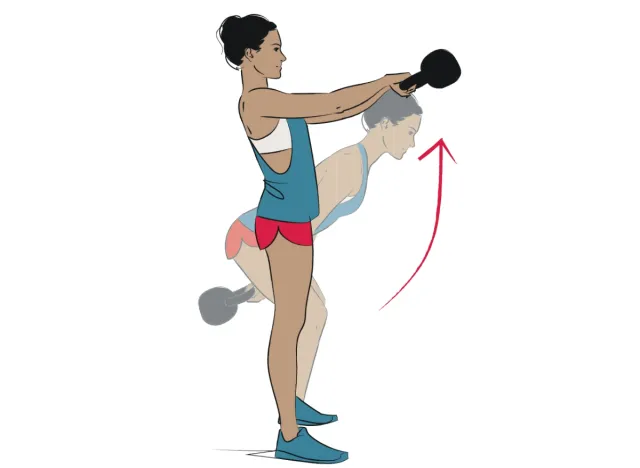
How to do it:
- Stand with your feet hip-width apart, holding a kettlebell with both hands.
- Hinge at your hips and slightly bend your knees while swinging the kettlebell between your legs.
- Drive your hips forward to swing the kettlebell up to chest height, keeping your core engaged.
- Allow the kettlebell to swing back down between your legs and repeat the movement.
- Complete the specified number of reps.
3. Med Ball Front Slam
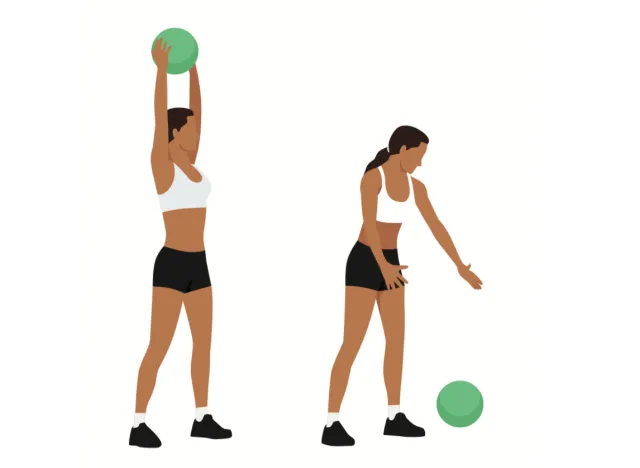
How to do it:
- Stand with your feet shoulder-width apart, holding a medicine ball overhead with both hands.
- Engage your core and slam the ball down to the ground in front of you as hard as you can.
- Catch the ball on the rebound and return to the starting position.
- Repeat for the specified number of reps.
4. Plank with Alternating Hip Drops
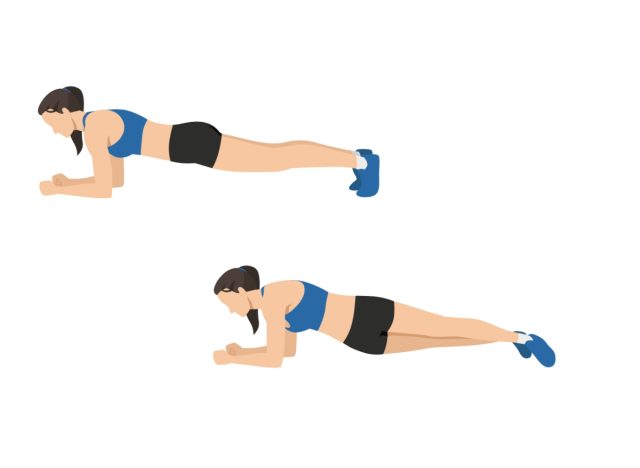
How to do it:
- Start in a plank position with your forearms on the ground and your body in a straight line.
- Slowly lower your right hip toward the ground, then return to the starting position.
- Repeat on the left side.
- Continue alternating sides for the specified number of reps.
Frequently Asked Questions about Strength Workouts for Six-Pack Abs
What are strength workouts?
Strength workouts are exercises that focus on building muscle through resistance training, such as weightlifting or bodyweight exercises. These workouts help increase muscle mass and strength in various parts of the body.
Why are strength workouts important for sculpting six-pack abs?
Strength workouts are important for sculpting six-pack abs as they help to build and define the muscles in the abdominal region. By increasing muscle mass and reducing body fat, these workouts contribute to achieving a toned and sculpted appearance.
What are the best strength workouts for six-pack abs?
- Planks: Planks are an effective core exercise that targets multiple muscle groups, including the abs.
- Crunches: Crunches specifically target the abdominal muscles and help to strengthen and tone the midsection.
- Leg Raises: Leg raises are great for targeting the lower abdominal muscles and improving core strength.
- Russian Twists: Russian twists engage the obliques and help to define the waistline.
- Mountain Climbers: Mountain climbers are a dynamic exercise that targets the entire core, including the abs.
How often should I do strength workouts to see results?
To see results in sculpting six-pack abs, it is recommended to incorporate strength workouts into your routine at least 2-3 times per week. Consistency and proper form are key to achieving desired results.
Can I combine strength workouts with cardio for better results?
Yes, combining strength workouts with cardio can help to maximize results in sculpting six-pack abs. Cardio exercises like running, cycling, or HIIT can help burn calories and reduce overall body fat, making the muscles more visible.






